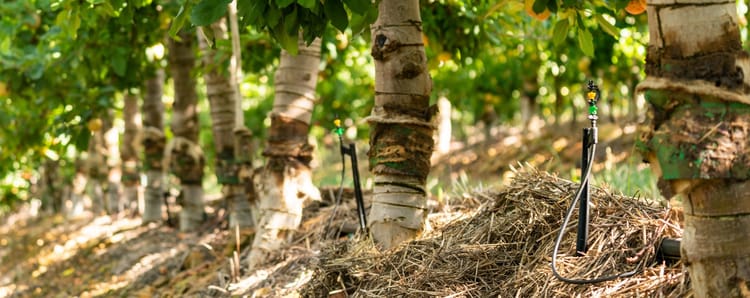Micro-sprinkler irrigation maintenance: What you need to know
Various factors determine the success of an irrigation system. To ensure that an irrigation system keeps functioning effectively and has a long lifetime, two factors should never be neglected – the use of quality products and system maintenance. In terms of product quality, the message is clear: You cannot afford to risk the financial viability of your project by not investing in the best possible irrigation equipment.
In a previous article, we discussed the important steps in drip irrigation system maintenance. In this article the focus will be on micro-sprinkler irrigation systems.
For more information regarding irrigation planning and selection, read the following articles in Netafim’s series:
The right micro-sprinkler system design
The main goal of micro-sprinkler system maintenance is to extend the lifetime of each sprinkler. Producers also need to make sure that each sprinkler delivers water efficiently and uniformly throughout its lifetime. The goal of precision irrigation is to deliver the right amount of water at the right time.
According to André du Toit, Netafim’s technical advisor in the Northern and Western Cape, micro-sprinkler system maintenance must be performed proactively. “We don’t want the system to break down during a peak irrigation period. We must also prevent damage caused by problems in the system that may lead to unnecessary costs.”
Consider system longevity
An important part of pro-active system care is the longevity of the system, which needs to be considered during the design phase. “We must, for example, ensure that the system is designed with enough air valves. Sprinklers are not air valves,” André explains. If air is pushed through the system to be released through the sprinklers, the sprinklers will spin too fast without the cooling effect of the water. This will lead to increased wear on the sprinklers.
As uniform water delivery is a priority, it is crucial that the system not only has a uniform design, but that it is also kept uniform when important maintenance activities are performed. “When you replace sprinklers or pipes during maintenance, it must be replaced with the same type and quality product. Replacement sprinklers must have the same delivery rate and be installed at the same height from the ground. Make sure that all replacement micro pipes are the same length,” he explains.
André explains that this is to prevent variation in water delivery, distribution and system pressure in one irrigation block. If variation occurs, it will have a negative effect on yield uniformity. “Actual micro-sprinkler flow rates must be checked to ensure that sprinklers still deliver water at the correct rates. Keep an eye on the water meter to pick up anomalies in the flow rate.”
Keep a watchful eye
The fact that the emitter allows easy visual inspection, is one of the advantages of micro-sprinkler irrigation. André says one must take full advantage of this. He explains that it is important to regularly walk through each irrigation block to check that sprinklers are upright, that no sprinklers are blocked by physical obstructions such as insects or mud, and that there are no obstructions, such as weeds, in the spray path of the sprinkler. Check that no sprinklers are broken and that all sprinklers are running and emitting water.
Any problems picked up during physical checks must be corrected immediately. If, for example, a sprinkler is wobbling, the spreader must be replaced. If it continues to wobble the entire sprinkler must be replaced. “Also be on the lookout for signs of salt deposits and algae. If this occurs, the sprinkler must be removed and cleaned before replacing it.” Check for wet spots on the main or sub-mainlines that will indicate leaks, as well as annual growth patterns that may indicate uneven water delivery.
Maintaining the correct pressure
System pressure is vital with regard to the longevity of a micro-sprinkler irrigation system. Incorrect pressure will not only damage the system, but will also lead to over or under irrigation. According to André, a system running at too high a pressure will cause increased wear on sprinklers and will increase the evaporation rate. Too low a pressure may lead to sprinklers that stop spinning, leading to uneven water distribution and higher wear.
André recommends that a pressure regulator be installed with the necessary valves and that the pressure of the system is tested regularly as part of system maintenance.
Keep it clean
Water quality can have a massive impact on the longevity of irrigation systems, making it one of the most important parts of such a system. Efficient filtration greatly contributes to the prevention of sprinkler clogging. Filtration technology has improved by leaps and bounds over the past few years, which means that clogged drippers pose less of a challenge in modern drip irrigation systems.
Click here to read about the selection of filters.
Depending on water quality, all laterals must be flushed from time to time. “It is an essential part of system maintenance. Flush a different lateral each week to keep in touch with the time it takes for matter to build up in the laterals,” says André.
Another key element in system maintenance is chemical treatments. However, this is not the case with micro-sprinkler irrigation systems. “We do not recommend chemical treatments as a solution to dirty micro-sprinklers and connected pipes. In a dripper there is enough velocity in the pipe to flush matter out, thus preventing matter from settling and clogging drippers. This is not possible given the position of sprinklers in relation to the laterals, which means that matter will end up clogging sprinklers.”


Share your thoughts
Comments
We'd love to hear your thoughts! To enter a comment, type your name and email address.